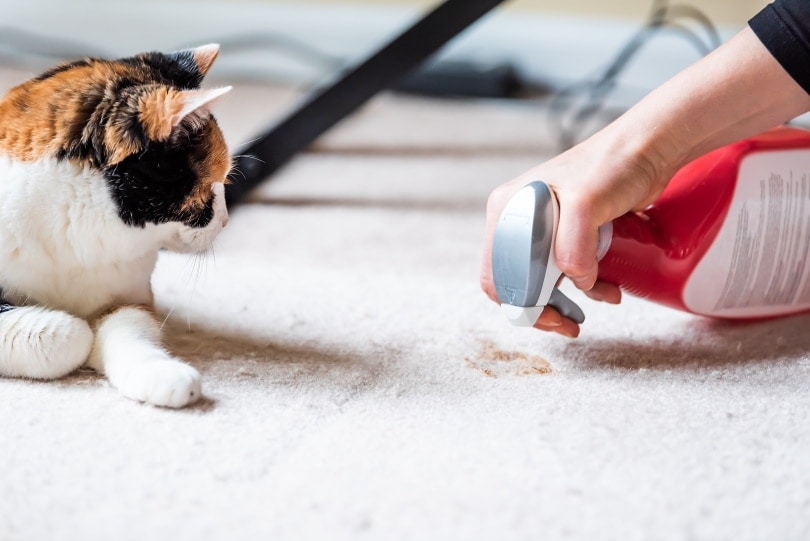Why Do Some Maine Coons Have Extra Toes? Polydactyl Cats Explained
By Dean Eby
Updated on

Click to Skip Ahead
Of course, this unique feature has started to make a comeback. In recent years, fanciers have prized the polydactyl Maine Coons, causing breeders to start accentuating the trait once again. Today, around 40% of all Maine Coons sport the extra toes. But why do they have them? How did this strange physical feature form, and does it help or hurt these cats in any way?
Feline Polydactyly
While Maine Coons are one of the most common examples of polydactyl cats, they’re not the only ones. In truth, any breed can produce polydactyl offspring. Unlike humans, cats don’t have the same number of toes on each foot to start with. Under normal conditions, a cat will have 18 toes in total, which works out to four toes on each of the rear paws and five on each of the front paws.
When a cat is a polydactyl, they have extra toes on any of their feet. Usually, a cat will have just two or three extra toes in total, but sometimes, they can grow many new toes instead. The cat that holds the world record for feline polydactyly has a whopping 28 total toes!
You may also hear of polydactyl cats referred to as Hemingway cats. Ernest Hemingway, the prolific author, was a feline fancier who owned about 50 cats. Nearly half of his cats were polydactyl, and he loved felines with extra toes. The name stuck, and polydactyl felines are still called Hemingway cats today, even though many people may no longer understand the reference!

Types of Polydactyly
Cats can have different types of polydactyly, depending on where the additional toes appear. For example, in postaxial polydactyly, more commonly called snowshoe paw, the extra toes are on the outside of the paw. If the extra toes are located before the dewclaw on the side of the paw facing the cat’s midsection, it’s known as preaxial polydactyly or mitten paw.
How Does Polydactyly Occur?
It takes just a single gene mutation to create a polydactyl cat. If the Pd gene in a feline mutates due to input from a polydactyl parent, there’s a 50% chance of them producing polydactyl offspring. So, we understand how polydactyly passes from parent to offspring, but where the trait started with Maine Coons is a bit more of a mystery.
Polydactyl Maine Coons were prized by sailors. Cats with the mutation were often found on ships traveling between England and the New World. Even today, cats in England, America, and Wales seem disproportionately affected by polydactyly compared to other cats worldwide.
The first polydactyl cats were on ships coming out of Boston. Many of the ships traveled between Boston and Maine regularly, and it’s believed that Maine Coons started mating with polydactyl cats on such trips, causing the trait to become prevalent in the breed.

Polydactyly Benefits for Maine Coons
When polydactyl Maine Coons were found on sailing ships, they were prized by the sailors on board. As it turns out, there are some profound benefits to having extra toes if you’re a cat. Maine Coons with extra toes were superior climbers. They had a stronger grip and could use their paws more like hands.
This allowed them to climb trees and masts more easily than felines without the extra appendages. This also made these extra-toed cats even better at catching mice, which is why they gained such favor with sailors, who considered the trait good luck.
Problems for Polydactyl Maine Coons
Most postaxial polydactyl cats won’t experience any issues with their extra toes. However, on rare occasions, preaxial polydactyl cats may need surgical intervention. For these cats, the additional toe or toes are located between their normal toes and their “thumb.”
These extra toes can fold over and grow into the foot. Generally, the claw on the extra toe is removed in those circumstances to avoid the pain and infection that may accompany the growth.

Can Polydactyl Maine Coons Compete in Shows?
If you want to show your polydactyl Maine Coon, there are opportunities, but it’s dependent on the organization. Some have accepted extra-toed felines, such as the New Zealand Cat Fancy Inc. or the International Cat Association, which both allow polydactyl Maine Coons.
However, others don’t recognize polydactyl Maine Coons and won’t allow them to compete, such as the Federation Internationale Feline (FIFe). In fact, this federation has entirely banned the registration and breeding of polydactyl Maine Coons altogether.
Conclusion
Polydactyl Maine Coons might have an evolutionary advantage over other domestic cat species. The Maine Coon is one of the largest domestic feline breeds, and about 40% of them sport extra toes, which can help them climb better than their normal-toed comrades, enabling them to be better hunters.
Sailors always prized the trait, and it’s becoming more popular with feline fanciers today, but Hemingway cats, as polydactyl felines are affectionately called, were not popular with breeders until recently.
Today, polydactyl Maine Coons are accepted by some feline fancier associations, but it may take time before they receive the same recognition that other Maine Coons get.
Featured Photo Credit: Kreminska, Shutterstock












